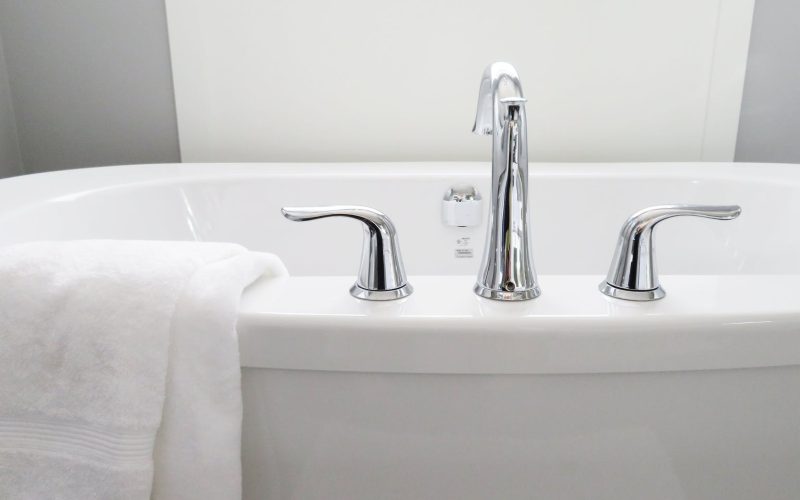Today, there are many different types of faucets available, thanks to advances in technology that allow us to make fixtures that fit practically any aesthetic design, functionality, or other characteristics you desire.
Your faucets are probably one of the first things that spring to mind when you think about plumbing fixtures in your home.
For as long as we’ve had flowing water in our homes, we’ve needed a way to regulate it, and that’s exactly what faucets do: give a steady flow of water when you need it and keep it contained and ready when you don’t.
So, please read on as we discuss some of the different faucets available in today’s market.
1. Ball Faucet
Ball faucets are single-handle faucets with a handle on top of a ball-shaped cap on the spout. The temperature is controlled by moving the single handle from side to side.
Lifting the handle controls the water flow. This ball assembly, which includes slots, O-rings, and spring-loaded rubber seals, functions the faucet.
Furthermore, these faucets require more care and frequent repairs than other types because they include a more significant number of parts, including rubber parts prone to wear and corrosion.
Also, they tend to leak, so monitoring them and ensuring they’re in good working order is crucial.
2. Disc Faucet
This is the most recent and possibly the best faucet technology. Two ceramic discs are at the bottom of the chamber, and the water temperature is controlled inside a disc faucet.
It is distinguished by its single-lever control and extensive, cylindrical body. The proportion of each is controlled by the side-to-side angle of the control lever in this chamber, where hot and cold water mingles.
Furthermore, these faucets are possibly the most dependable market today, requiring extremely little care and infrequent repairs.
However, repairing the faults these faucets can have is complex, and it’s generally recommended that you hire a professional to get it fixed properly so it lasts.
3. Cartridge Faucet
Cartridge and compression faucets are nearly indistinguishable until you get a feel for how they work.
Cartridge faucets are often smoother than compression faucets, having a continuous and soft feel along the twisting axis.
A half-turn turns the faucet from off to entirely on, then back off without exerting more pressure or effort. As a result, as opposed to round, valve-style handles, cartridge faucets typically have lever-style handles that are easy to grab and operate.
Due to their cartridge construction, cartridge faucets are often lower maintenance and more reliable than compression faucets. Furthermore, this is one of the different types of faucets available.
4. Compression Faucet
Compression faucets are also double-handled, meaning the hot and cold water lines are each controlled by a separate handle on the side of the water spout.
On the other hand, a compression faucet is easily identifiable because it feels less pressurized when it opens and more pressurized when it closes.
This is because they work by employing a glorified screw that pushes against a rubber washer to create a seal that shuts off your water supply.
This is also why they usually have circular knobs that are easier to spin over a longer distance than cartridge faucet handles. Also, this is the oldest faucet technology on the list and one of the most common and affordable.
However, they wear out rapidly and require maintenance as they begin to leak quickly, even though there may be a limitless number of faucets on the market.
The vast majority can be categorized into one of the four mentioned above. However, there are also some other different types of faucets used in the bathroom, and they are:
5. Centre Set
A center-set faucet is one of the most common types of bathroom faucets found in homes and hardware stores.
This faucet has a compact body and one or two handles or knobs for controlling water pressure and temperature.
Also, if you reside in New York City and have limited space to spare, this is a fantastic option with a shorter spout.
6. Single Handle Faucet
A single-handle faucet does precisely what it says on the tin. It has just one handle that controls temperature and water pressure.
The handle will be right, left, or straight above the spout. It may be mounted in a considerably smaller space because it doesn’t require much drilling to secure.
It will fit in around two or three inches in width. This is one of the simplest types of faucets to set up independently.
7. Spread Fit Faucet
Like a center-set faucet but with more liberal spacing, a spread-fit faucet has three independent components that protrude out from the surface of the sink.
Take a look at how unconcerned those knobs are. They aren’t crowded and ready to give whatever water temperature you require.
8. Bridge Faucet
The bridge faucet’s beautifully smooth bridge-like appearance is self-explanatory (they make it so simple for us, don’t they?). These are frequently seen in commercial sinks, where cleanliness is a top issue.
Two independent knobs control the temperature, and this form of faucet often includes a pull-away spray sprayer.
9. Wall Mounted Faucet
The wall-mounted sink is ideal for more modern bathroom settings, as it was designed with floating sinks in mind.
Furthermore, take some measurements, as having a faucet that doesn’t reach the edge of your sink would be embarrassing (I’ve seen this previously, and it was ridiculous). A faucet linked to the wall allows you to switch out sink basins easily.
10. Sprinkle Faucet
The spout on a sprinkling sink faucet is unusual. Instead of a standard cylindrical spout, the water is dispensed in a rectangular pattern (very contemporary!).
The spout will be rectangular, with a grating at the mouth that allows the water to flow in a rectangular pattern.
11. Tub Wall Mount Bathroom Faucet
Wall-mount faucets and tub wall-mount faucets are comparable. The only difference is that they mount to the tub wall rather than the bathroom wall.
Both the spout and the faucet handle are inserted directly into the tub. This means they won’t work as a shower faucet spout, but they’re a perfect option if you only need a faucet for a freestanding tub.
Furthermore, Tub wall faucets are rarely found in ordinary built-in bathtubs; people use them for freestanding or clawfoot baths instead.
This adds extra work to the installation process because you’ll need to ensure the faucet can connect to the waterline, which may require a diverter valve.
12. Deck Mount Bathroom Faucet
Deck-mounted faucets are commonly found on more enormous bathtubs, which is a choice for a solitary bathtub rather than a shower.
Instead of protruding from a wall, these faucets sit on the lip of the bathtub. This is one of the different types of faucets.
Furthermore, if your bathtub has a large rim that prohibits access to the wall, these are fantastic options. However, it’ll be a little more complicated if you have to connect the faucet to a supply line before connecting it to the waterline.
On the other hand, Deck mount faucets lend to a clean, contemporary appearance.
13. Roman Tub Faucet
Although a Roman tub faucet resembles a deck-mount faucet, there are a few minor variances. Knowing the distinctions won’t help you win at trivia night.
But you’ll want to know what they are if you’re looking for a faucet for your vast bathtub. The faucet on both versions sits on the tub’s rim.
A supply line connection is required for both types, and the discrepancy is due to the spout’s form. Furthermore, a Roman bathtub spout has an arched design, but standard deck-mount faucets have a more traditional appearance.
Hand showers are occasionally included with Roman faucets, and they essentially combine the bathing and showering experiences into one.
A hand shower is a head you can move around with your hand. To have that option, you’ll need to drill an extra hole in your tub with your Roman faucet.
However, it requires a bit more effort upfront. The handheld shower option can be highly beneficial to people with limited mobility.
14. Freestanding Tub Faucet
This is one of the different types of faucet spout frequently paired with a clawfoot bathtub or other freestanding tub. This faucet can also be seen in a shower with an eclectic design.
This type of faucet is attached to the floor directly, and it can be used to create various looks, including vintage and industrial.
Furthermore, the look incorporates exposed pipe, so consider that while deciding. A freestanding faucet can have a spout that hangs over the tub and fills it from above, or it can be attached to the tub directly through pre-drilled holes.
Ensure you have under-floor access to the waterline before choosing this type of faucet. A water supply pipe may also be required.








